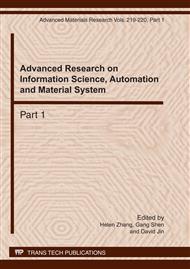p.202
p.206
p.210
p.214
p.219
p.223
p.228
p.235
p.239
Multi-Layer Model for Network Fault Detection Based on Artificial Immune
Abstract:
In order to reduce the fault detection rate and improve the self-adaptive capability in network fault detection, an artificial immune mechanism which is inspired by multi-layer defense of a biological immune system is proposed to perform network fault detection. The immune model is composed of three parts: the inherent detection layer, fuzzy judgment layer and adaptive detection layer. Dendritic cells can influence the reaction of coordinating T-cells, which can be activate or tolerate so that induce adaptive immune responses and affirm the type of adaptive response. Inherent detection layer and fuzzy judgment layer interact with each other to reduce the error detection rate, while the adaptive detection layer is capable of learning unknown fault patterns.
Info:
Periodical:
Pages:
219-222
Citation:
Online since:
March 2011
Authors:
Price:
Сopyright:
© 2011 Trans Tech Publications Ltd. All Rights Reserved
Share:
Citation:


